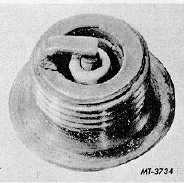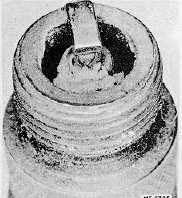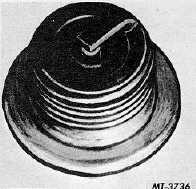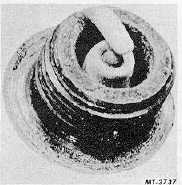|
| |
TRUCK SERVICE MANUAL
TM 5-4210-230-14&P-1
ELECTRICAL
Normal Conditions
Normal conditions are shown in Fig. 4. The plug
shown has been running at the correct temperature. The
deposits present will be light tan or gray in color with most
regular grades of commercial gasoline; if LPG is used, the
color will be predominately brown.
Fig. 4 Normal Spark Plug Appearance
Core Bridging
Core bridging, Fig. 5, will be encountered only rarely in
automotive engines. Deposits accumulated after a long
period of misfiring may be suddenly loosened when normal
combustion temperatures are restored upon installing new
spark plugs. During a high-speed run these materials
shedding off the piston are thrown against the hot insulator
surface.
Fig. 5 Core Bridging
This action forms a bridge between the insulator and
shell, resulting in a "dead short." Such evidence of excessive
combustion chamber deposits will be most common where oil
control is poor or where vehicles are usually driven in slow
speed, start-stop service. In such instances it usually pays to
physically remove accumulated deposits from the engine.
Cold Fouling
Cold fouling or carbon deposits are illustrated in Fig. 6.
This dry, black appearance usually means that the next hotter
plug should be substituted. However, if only one or two plugs
in a set are fouled, check for sticking valves or bad ignition
leads. Fouling of the entire set may be caused by a clogged
air cleaner, a sticking heat riser or a faulty choke.
Fig. 6 Cold Fouling
Overheating
Overheating, illustrated in Fig. 7, is indicated by a
dead white or gray insulator which appears "blistered. "
Electrode gap will be considerably worn. This suggests that a
cooler heat range should be used; however, overadvanced
ignition timing, detonation and cooling system stoppages can
also overheat the correct spark plug heat ranges.
Fig. 7 Overheating
Turbulence Burning
Turbulence burning, shown in Fig. 8, causes
electrodes to wear away on one side. This is the result of
normal turbulence patterns in the combustion chambers of
certain engines. It can be ignored if normal plug life is being
obtained. If gap growth appears excessive, review the
corrective measures suggested under "Overheating."
CTS-2016-J Page 4
PRINTED IN UNITED STATES OF AMERICA
|




